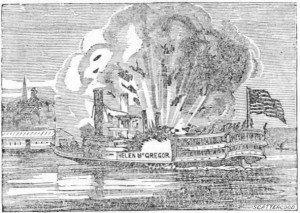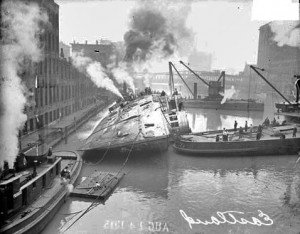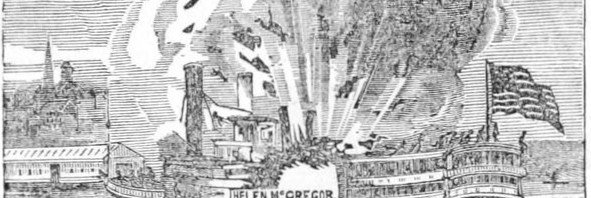The Great Lakes have produced some of the most severe storms and waves on the surface of the earth. In this unpredictable environment was the burgeoning Great Lakes shipping industry. The toll on lives and vessels traversing the Great Lakes since the earliest times has largely been lost to history. Shipwrecks on the Great Lakes have been around as long as man has been sailing on them.
Thank you for reading this post, don't forget to subscribe!Beginning in the 1840s, lumber, coal, iron and agricultural products were hauled by boats over the Great Lakes. As an example, iron ore from the upper lakes region was carried east on ships that returned filled with coal from Pennsylvania. The early ships that traveled the lakes helped build the great cities of Cleveland, Chicago and Detroit among others. The lake boats were the economic catalyst of the entire Great Lakes region.
On the Great Lakes During the Mid 1800’s
The year of 1850 proved to be the most deadly of any Great Lakes shipping season up to that date. The Great Lakes truly do have a shipping season since the winter months largely ice over all of the lakes. The season generally runs March through November although November has always been a question mark. The storms of November are infamous for taking down many vessels, large and small.

The loss of lives and ships during 1850 however didn’t seem to need much help from mother nature. If you were to name the biggest danger to ship, crew and passengers during this mid 1800’s time, aside from mother nature and storms, you would probably point to boiler explosions. In fact, steamboat boiler explosions raised havoc all throughout the eastern U.S. waterways. The boiler explosions of 1850 were not the first and they certainly weren’t the last. Most historians might say that the second culprit was fire. Fire not related to boiler explosions would be combustibles in the boats cargo hold. There was even a Great Lakes steamboat fire started by someone tamping out his smoking pipe on the wood deck. This was an era of wooden steamboats. Whether it by explosion or by fire, a wooden vessel would go up in flames many times faster than someone could leap overboard or put on a life jacket. Add to this the absence of any meaningful safety regulations and a culture among captains and crews of racing and you have the proverbial “accident waiting to happen”.
In this atmosphere was a country growing immensely. The mid 1800’s was an era of massive immigration. The Great Lakes served as a highway to the frontier because in 1850 the western frontier would have been roughly anything from Chicago westward. The forests of the upper Great Lakes would go on to provide needed lumber and would supplant the eastern forests which were essentially decimated. The Great Lakes was the often used route for immigrants from Europe who came to the U.S. with their life savings for the purchase of land.
A European immigrant might travel from New York City to Buffalo New York where he or she might then board a steamer for points west. Points west would include, among others, Cleveland, Toledo, Detroit, Milwaukee and Chicago. If the passenger had the funds then he or she might travel in a private cabin. If not, then steerage was the option and steerage accounted for the majority of travelers. Keep in mind, many of these people had already endured a lengthy voyage on the ocean before even arriving in Buffalo. In 1850, steamboat traffic on the Great Lakes was enormous. Today, we look at the Great Lakes as a venue for lake freighters and pleasure craft. In 1850 it represented the equivalence of the Santa Fe Trail, although without Indian attacks, for people wanting to travel to cities like Detroit and Chicago.
The Worst Disaster of 1850
Shipwrecks in the Great Lakes seemed to have been not an uncommon occurrence. During the infamous 1850 Great Lakes shipping season, the largest of all 1850 disasters occurred on June 17th. The burning of the steamer G. P. Griffith about twenty miles east of Cleveland, cost 286 lives to be lost. Some estimates I’ve seen put the total at 326. This was one of the greatest single event loss of life in Great lakes history. This disaster was the second of Lake Erie’s three great passenger steamer tragedies and the worst nautical disaster on the lakes until the SS Eastland capsizing while at port in Chicago in 1915. In that disaster, 844 people lost their lives. What’s incredible is that the worst Great Lakes loss of life occurred while the boat was tied up at a Chicago River dock. You might expect great shipwrecks to occur during a storm or during an uncontrollable fire, but what happened to the SS Eastland is almost beyond belief.

On the G P Griffith, one woman was the sole survivor and what is so surprising about the Griffith loss was that it occurred just three miles from shore. A fire was reported in the hold at about 4 in the morning. One seaman took the wheel and tried to steer the boat to shore but hit a sandbar reportedly only about 600 feet from shore. The vessel burned all the way to the water line while passengers jumped in the water. Lights could even be seen on shore but with the panic that ensued the shore could have been 100 miles a way. Burned bodies would have to be buried on the shoreline and there they stayed. The G.P. Griffith disaster was not only a Great Lakes boating disaster but it was a tragedy for the mostly German, Irish, English and Scandanavian immigrants who had traveled so far already just to have their lives snuffed out so close to their intended destinations. Also among the victims were the captain and his family who was traveling with him.
With the lax regulations in place, boats built of wood, steam boilers that were sometimes left unattended and the eagerness to race a break time records, it’s almost amazing that there were not more accidents and lives lost during the mid 1800’s. It’s estimated that the Great Lakes are home to some 8,000 shipwrecks and about 2,000 of them are located in Lake Erie. One-hundred and fifty years ago Lake Erie would have looked like a traffic jammed street. Lake Erie for centuries was a bustling water highway. It’s reported that the majority of the Great lakes shipwrecks have not been discovered even to this day. Each year more wrecks are discovered. Some have been found by fishermen while working with their nets. Diving expeditions, which I hear draw divers from all over the world, are undertaken each year. By inputting as much information that is available, maps of Great Lakes shipwreck locations have been plotted out and these are referred to by divers. Shipwreck maps are often updated when new information is discovered.

If you’re somewhat familiar with the Cleveland Ohio area, the area of the sinking, according to a Willowick Ohio web site, is approximately an area north of Lake Shore Blvd. from Cresthaven to East 305th Street.
Today, there is a memorial in place in regards to the G P Griffith tragedy at Lakefront Park in Willowick Ohio, east of Cleveland.
I also have a short article about the devastating steamboat boiler explosion at the docks of Lawrence Kansas. Also an interesting article on the Mosquito Fleet and wrecks on Washington State’s Puget Sound. Another Great Lakes related story which is very interesting concerns the break up and sinking of the lake freighter Carl D. Bradley during a fierce Lake Michigan November storm.
There are several good sites to stop by while vacationing in the Great lakes region. Visiting these sites will give you a lot of the history about the lakes and chances are you’ll be surprised by many of the stories exhibited. One is the Great Lakes Shipwreck Museum located at Whitefish Point, 18335 N. Whitefish Point Road, Paradise, Michigan. Another is The Dossin Great Lakes Museum. The museum is located in Detroit Michigan on the shore of Detroit’s historic Belle Isle, one of America’s grandest city parks. In Vermilion Ohio, on the south shore of Lake Erie. west of Cleveland is the Inland Seas Maritime Museum. The address is 480 main Street, Vermilion Ohio. Add to this list The Chicago Maritime Museum. The address is310 South Racine, Chicago Illinois. The museum celebrates the men and women who built, crewed, loaded and unloaded the ships and later on used Chicago’s waterways for enjoyment and recreation. The Lake Superior Maritime Visitor Center is a museum operated by the U.S. Army Corp of Engineers and is located at the entrance to the Duluth-Superior harbor in Duluth Minnesota. The five listed sites are only a few of the total scattered around the Great Lakes. There are many more interesting stops in all states that border the Great Lakes.
(Photos are in the public domain)

